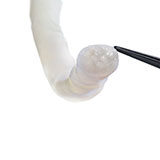nerve biopsy procedures
Reconstructing the nerve at the time a biopsy is taken is important because it has been shown to reduce the risk of decreased quality of life and significantly reduce the likelihood of post-biopsy worsened neuropathic pain compared with standard techniques.1 Up to half of patients who have a nerve biopsy procedure experience subsequent chronic comorbidities, including nerve pain, discomfort, dysesthesias, paresthesias and loss of function.1,2
The primary factors driving nerve pain after biopsy are direct trauma to the nerve, deafferentation and neuroma formation.3
Reconstructing the nerve biopsy site addresses multiple mechanisms of potential pain generation by preventing or reducing neuroma formation and allowing potential nerve regeneration to address the deafferentation while allowing for adequate biopsy lengths.1
remember the following:
- One of a surgeon’s most feared complications of nerve biopsy is new or worsened neuropathic pain as it can affect 28% of patients who do not receive nerve reconstruction.1
- Literature shows spontaneous sensory recovery rates after nerve harvest range from 0%–11.1% in adults.2
- Reconstructing the nerve significantly reduced postoperative neuropathic pain at six months following biopsy procedures.1
- Processed nerve allograft allows for the recommended 5 cm biopsy length to be repaired.1
more procedures
There’s only a short form between you and our nerve product team who can help you get more information about our nerve repair solutions.
references
- Sakamuri S, et al. Allograft nerve repair reduces postoperative neuropathic pain following nerve biopsy. Neurosurgery. Dec 2020;87(6):E638-E645.
- Ducic I, et al. Chronic postoperative complications and donor site morbidity after sural nerve autograft harvest or biopsy. Microsurgery. Sep 2020;40(6):710-716.
- Costigan M, et al. Neuropathic pain: a maladaptive response of the nervous system to damage. Annu Rev Neurosci. 2009;32:1-32.

